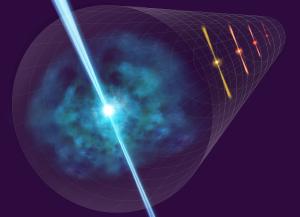Blog
Burst of Knowledge
23 July 2022
 NAOJ
NAOJNow that the James Webb Space Telescope is operational, astronomers can study some of the most faint and distant galaxies ever seen. By some accounts, we may have already captured the image of a galaxy from when the universe was just 300 million years old. But we can’t be entirely sure of its distance, and that is a big problem for astronomers.
How do you measure the distance of the farthest galaxy? If you’re an astronomer, you rely on its observed redshift. Since the universe is expanding, the more distant the galaxy, the more redshifted its light. To calculate the galaxy’s distance, astronomers plug the redshift into a formula derived from the standard cosmological model. By observing everything from variable stars to distant supernovae, we know the relationship between redshift and distance really well. So do the math, and get the distance.
Of course, the most distant galaxies are farther away than the calibrating observations of the standard model. We can extrapolate the standard model for these galaxy distances, but that assumes the cosmic acceleration wasn’t radically different way back then. There’s no reason to assume our assumption is wrong, but it would be nice to get distance measurements at the limits of Webb’s galaxies. Unfortunately, the type of supernovae we use for these distance measurements aren’t bright enough to be seen at that distance. But a new study finds we might be able to use gamma ray bursts instead.1
Gamma-ray bursts, or GRBs, are short-lived explosions of gamma radiation. They are likely caused by hypernova explosions of giant stars, and they are extremely powerful. A single GRB releases more energy than the Sun will emit in its entire 10-billion-year lifetime. But the light curves of GRBs are complex, making it difficult to find a common pattern.
In this latest study, the team didn’t look at the variation of gamma-ray light but instead looked at optical light. They looked at the optical light curves of 500 known GRBs and found nearly 180 with a common pattern. Many of these GRBs are close enough that we know their distances, so the team was able to use their observed brightnesses to calculate the actual brightnesses. This means that if a really distant GRB of this common type is detected, astronomers can use its observed brightness to calculate its distance, thus extending our cosmic distance ladder. In time, we might be able to test our assumption about the standard model with this technique.
So while everyone is rightfully excited about the discoveries of the James Webb Space Telescope, it’s nice to know that astronomers are also working on tools to support the discoveries Webb will make.
Dainotti, Maria Giovanna, et al. “The Optical Two and Three-Dimensional Fundamental Plane Correlations for More than 180 Gamma-Ray Burst Afterglows with Swift/UVOT, RATIR, and the SUBARU Telescope.” The Astrophysical Journal Supplemental 261 (2022): 25. ↩︎